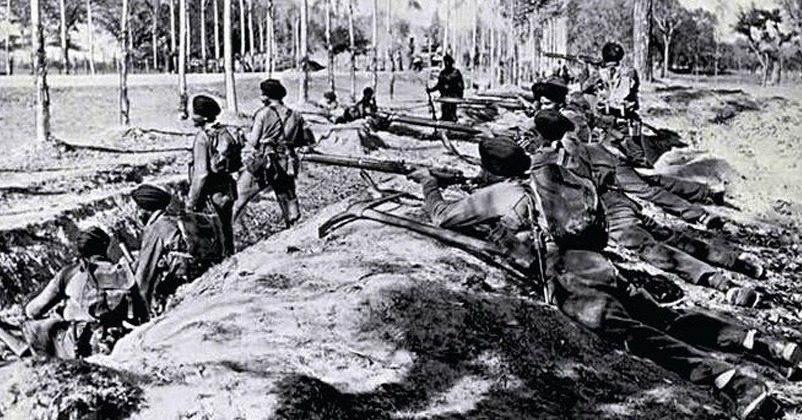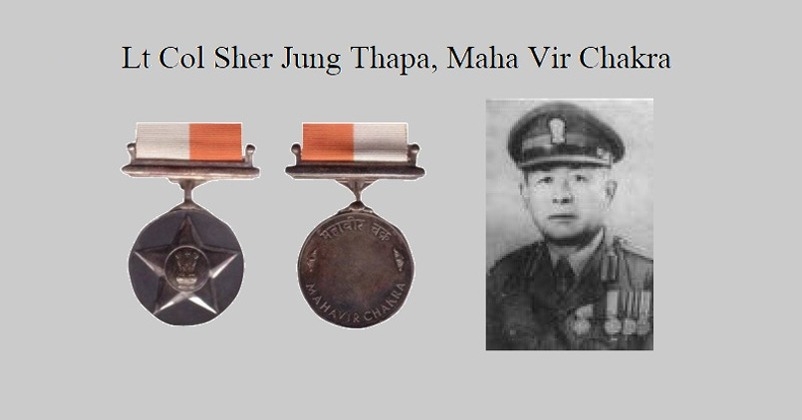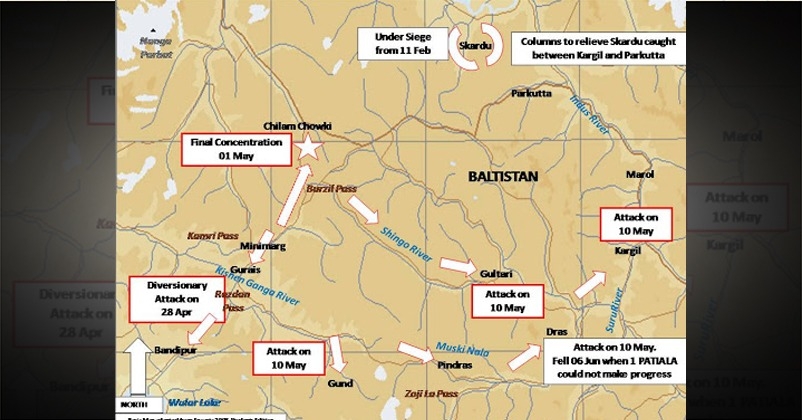BATTLE OF SKARDU- a story of determination, courage and hope- Indo-Pak war
14 Feb 2020 20:26:18

After Indian independence, Pakistan started its cheap war tactics. One such event was Skardu battle in J&K. By mid-November 1947, the Gilgit Scouts of Pakistan had secured the entire Gilgit Agency. Sardar Mohammad Alam flew into Gilgit from Peshawar to take over its administration on behalf of Pakistan. Soon Pakistani forces arrived to coordinate further operations towards Skardu-Kargil-Leh and Dras. The winter prevented any major operations towards Leh, Kargil and Dras, but Skardu at an altitude of 7000-8000 feet, was blocking the track to Kargil and Leh.
Pakistan’s preparations
By early February, all the preparations had been made. Major Ehsan Khan and Captain Muhammad Khan and Lieutenant Baber Khan, mustered a mix force – Ibex Force of 600 men which consisted of Gilgit Scouts, Chitral Scouts, deserters of the 6 JK Infantry and local militia. They marched up the Indus River and on the night of February 9/10, attacked the covering force positioned at Tsari. The Muslim platoon on the right bank under Capt Nek Alam was won over and the Sikh platoon on the left bank of the river under Captain Kishan Singh was attacked. Surprise was total and the platoon was annihilated. There were only a few survivors who were taken prisoner and killed by their former comrades.
Betrayed by own men
On February 11, early morning, the garrison of Skardu woke to the rattle of musketry and shouting. The Muslim platoon of the garrison deserted and joined the enemy. The void was quickly filled up by resting troops of Capt Prabhat Singh. The enemy attacked with vigour, but was met with a disciplined hail of fire from the defenders. The fighting continued for six hours. Some outposts were captured but were recaptured with counter attacks. After a battle the attack was beaten back with the enemy leaving behind 10 killed and one wounded.

Constant defending
Frustrated, the enemy now targeted the town below which was sacked and plundered. A large number of people were killed and their properties looted. However, some managed to reach the safety of the garrison including Wazir Wazarat, Shri Amarnath. The defenders had 7 other ranks killed and one officer and 16 other ranks wounded. Three Muslims who manned the Wireless Telephony (WT) set had deserted.
Between February 15 and March 16, a number of clashes took place and in all cases the defenders came away the better.
Hope still alive
Sher Jung Thapa kept his troops motivated despite reduced rations, increasing casualties and incessant battle. He had advocated a temporary withdrawal to Kargil to build up for the counter offensive. However, he was ordered to hold Skardu at all costs. The strategic plan was to build up at Skardu and use it as a base for recapture of Gilgit-Baltistan. He also used this to inspire his troops to fight. He reminded the troops that their forefathers had shed their blood to capture this area under General Zorawar Singh 100 years ago. But he needed supplies and reinforcements but supplies were ruled out due to altitude ceiling.
Consistent attacks by Pakistan
On March 15, Thapa’s lookouts reported some raiders heading towards Gol. The next day, a larger body of the raiders headed in the same direction. Thapa was well aware that a relieving column was on the way and expected them to arrive on March 18. He realised that the raiders were going to intercept this column. He could not warn the ‘Biscuit Column’- a relief column on the WT as their only WT set had broken down at Kargil and was dumped there. Thapa had conveyed his fears to Srinagar with a request for air strikes against the raiders. Unfortunately, no air support was forthcoming.
On March 17, Brigadier Faqir Singh’s ‘Biscuit Column’ commenced the last leg of the march. The column entered the gorge without taking fundamental tactical precautions of searching the defile with patrols and placing pickets for flank protection. Once in the gorge, all hell broke loose. Surprise was complete and panic ensued. The Brigadier was himself wounded and ‘Biscuit Column’ fell back all the way to Kargil to reach there on March 21. Supplies being carried for the Skardu garrison were also lost.
On March 29, the enemy decided to launch a night attack and concentrated on two posts of ‘School’ and ‘Raja House’ to break through the crust of the defences. These posts, under Captain Ajit Singh and ‘Jemadar’ (Naib Subedar) Piar Singh, had been isolated and cutoff from the main defences on March 28 itself, but the troops held on against all odds. Captain Ajit Singh was wounded on March 30 but did not leave his post. Sher Jung Thapa launched a counter-attack to rout the enemy attacking the two posts. The enemy pulled back.
The enemy made another attempt on April 7. The ‘School’ post was cut off once again. As the dawn came up on April 10, Naik Chatru of 6 JK Infantry led a desperate sortie from the Fort. They cut their way through the raiders to reach the ‘School’ picquet, who were at their last gasp. The raiders gave up, demoralised by their casualties.
The resistance of the Skardu Garrison notwithstanding, the enemy was busy making plans for an audacious operation to seize the entire Baltistan-Ladakh region and in doing so, rout the reinforcement column stretched between Zozi La and Parkutta.
Using the Gilgit Scouts numbering approximately 600 personnel and 200 deserters of 6 JK Infantry as the mainstay, a militia force of 2000 soldiers was created. Chitral Scouts also joined this force. Since all personnel were locals of the area, they were masters of the high altitude terrain. Field craft and marksmanship were natural to them.
Lt Col Alam Khan, a regular Pakistan Army officer who was involved with the invasion of the Valley in end October 1947, arrived in December to coordinate the operations.
However, the leadership was provided by the three officers of the Gilgit Scouts – Major Ihsan Ali Khan and Captain Hassan Khan of 6 J&K Infantry, and Lieutenant Shah Khan of the Gilgit Scouts. The line of communications from Sonamarg to Skardu ran parallel to the battle-front. The intent of the enemy was to interdict the line of communications, isolate the reinforcement columns and destroy them, and capture Zozi La, Drass, Kargil and Leh. The entire force was divided into three columns each of 600-800 soldiers, backed by a larger number of porters and ponies. The force level was maintained during operations by training new recruits.
Ibex Force under Major Ihsan Ali Khan was to operate on Axis Gilgit-Skardu-Kargil, to prevent reinforcements from reaching Skardu, isolate and capture Skardu, and later to conduct operations towards Leh in conjunction with the Tiger Force. The Tiger Force under Captain Hassan Khan was to operate on Axis Bunji-Kamri-Gurais-Bandipura to preempt the Indian Army counter-offensive to recapture the Northern Areas in summer of 1948 and open a new front in the Valley. The Eskimo Force under Lieutenant Shah Khan had the most ambitious task. It was to advance on Axis Astor-Deosai-Gultari-Drass-Kargil and sever the communications between the Valley and Kargil/Leh. It was to isolate the garrisons at Drass, Kargil and Leh and capture them. The code name given was Operation Sledge.
Operation Sledge
All operations were set to commence on May 10. But, the Ibex force had been attacking Skardu since February 11 and had also simultaneously, routed the Biscuit Column. It now left a small force to contain the beleaguered Skardu garrison and began the task of isolating and routing the elements of Sugar column stretched between Parkutta and Kargil.
By first week of May 1948, all columns had carried out the approach march over treacherous high altitude terrain and commenced operations in their respective areas on May 10. The battalion strength reinforcement columns between Parkutta and Kargil ceased to exist as fighting force by end May. Kargil was captured on night of May 10/11. Drass was captured on June 6. After a month’s fighting even the formidable 1 Patiala was forced to withdraw to Zozi La by July 7. Due to paucity of resources and energetic action taken to defend Leh, the enemy could only advance up to Nimu.The Skardu Garrison watched with dismay the rout of a two battalion size reinforcement column between Parkutta and Dras by an enemy force one-third of its size in just under four weeks.

Struggling till last breath
The bravehearts of the garrison were the last men standing of the Indian Army in the entire Baltistan region. They were determined to go down fighting. The garrison had 550 souls who had to be fed. Some food grains had been collected from private houses before the siege began but that was all. As the weeks went by, daily rations were cut to 250 grams of wheat flour and 30 grams of ‘Dal’ per day. The sick and the wounded suffered in silence. The attacks became less intense in May, June and July since the bulk of the Ibex force had pulled out for the riposte. The garrison was besieged by a force of 200 soldiers.
However, sniping and mortar shelling was constant. Offensive patrolling had become impossible and the garrison was soon hemmed in a perimeter of 1350 metres long and 550 metres wide area.
On June 17, the raiders sent a messenger from Parkutta, Sepoy Amar Nath of 5 JK Infantry under a flag of truce. He carried a letter from Colonel Shahzada Mata-ul-Mulk, son of the Mehtar of Chitral addressed to Lieutenant Colonel Thapa.
On June 19, two Tempest Fighter aircraft of the RlAF attacked positions around the Fort which brought much cheer to those inside. Supply drops from these Tempest aircraft were received on June 28, July 1, 8, 11 and 17. But they were not enough for their requirement.
July, brought only misery to the defenders. Barley was now the main diet, malnutrition had set in, except for a steely indomitable will, the physique of the defenders now displayed clothes hanging on frames.
By August, the garrison was reduced to two ‘chapatties’ of barley and a cup of tea per day. On August 4, a conference was held. It was strongly felt that since no assistance had reached them for over six months, the garrison be permitted to break out and hope for the best. This was conveyed to Major General KS Thimayya, DSO who ordered that no withdrawal will take place without his permission.
On August 7, aircraft attacked the enemy positions and dropped two containers of supplies, a pittance indeed. August 9 was announced by the loud boom of a new gun, two 3.7 inch howitzers had now been brought in for the kill.
August 12 witnessed a determined attack by 200 enemy soldiers on a picquet just outside the Fort. Hand-to-hand combat ensued. With ammunition running low, the last box of ammunition from the Fort was rushed to them. The attack was repulsed, the enemy withdrew leaving behind a pile of their dead. It was, however, the beginning of the end. Rations had finished and only 10 cartridges were left with each rifleman.
Declaring ceasefire and suffering ends
The day of August 13 passed slowly and as night fell, those of the garrison who could and wished to, were allowed to slip away from the Fort in small groups. Permission to surrender was granted and conveyed by Colonel Shri Ram Oberoi of the Srinagar Division and the struggle came to end